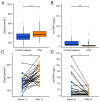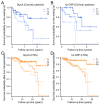Plasma GlycA, a Glycoprotein Marker of Chronic Inflammation, and All-Cause Mortality in Cirrhotic Patients and Liver Transplant Recipients
- PMID: 39859175
- PMCID: PMC11765328
- DOI: 10.3390/ijms26020459
Plasma GlycA, a Glycoprotein Marker of Chronic Inflammation, and All-Cause Mortality in Cirrhotic Patients and Liver Transplant Recipients
Abstract
Low-grade chronic inflammation may impact liver disease. We investigated the extent to which circulating GlycA, a glycoprotein biomarker of low-grade inflammation, and high-sensitivity C-reactive protein (hs-CRP) are altered in patients with cirrhosis and liver transplant recipients (LTRs) and examined their associations with all-cause mortality. Plasma GlycA (nuclear magnetic resonance spectroscopy) and hs-CRP (nephelometry) were assessed in 129 patients with cirrhosis on the waiting list for liver transplantation and 367 LTRs (TransplantLines cohort study; NCT03272841) and compared with 4837 participants from the population-based PREVEND cohort. GlycA levels were lower, while hs-CRP levels were higher in patients with cirrhosis compared to PREVEND participants (p < 0.001). Notably, GlycA increased, but hs-CRP decreased after transplantation. In LTRs, both GlycA and hs-CRP levels were higher than in PREVEND participants (p < 0.001). Survival was impaired in patients with cirrhosis and LTRs with the highest GlycA and the highest hs-CRP tertiles. In Cox regression analysis, GlycA remained associated with mortality in cirrhotic patients after adjusting for potential confounders and for hs-CRP (HR per 1-SD increment: 2.34 [95% CI 1.07-5.13]), while the association with hs-CRP after adjusting was lost. In LTRs, both GlycA and hs-CRP were also associated with mortality (adjusted HR: 1.60 [95% CI: 1.2-2.14] and 1.64 [95% CI: 1.08-2.51], respectively) but not independent of each other. GlycA increases while hs-CRP decreases after liver transplantation. Both inflammatory markers may be associated with all-cause mortality in cirrhotic patients and LTRs, while the association for GlycA seems at least as strong as that for hs-CRP.
Keywords: GlycA; chronic inflammation; hs-CRP; liver cirrhosis; liver transplantation; mortality.
Conflict of interest statement
M.A.C. is an employee of Labcorp. M.A.C. assisted with the generation of the NMR measurements and with the interpretation of the data. Labcorp was not involved in the study design, the data analysis, or the decision to publish the results. The rest of the authors declared that they have no competing interests.
Figures



References
-
- Serrano M.T., Sabroso S., Esteban L.M., Berenguer M., Fondevila C., Lorente S., Cortés L., Sanchez-Antolin G., Nuño J., De La Rosa G., et al. Mortality and Causes of Death After Liver Transplantation: Analysis of Sex Differences in a Large Nationwide Cohort. Transpl. Int. 2022;35:10263. doi: 10.3389/ti.2022.10263. - DOI - PMC - PubMed
Publication types
MeSH terms
Substances
Grants and funding
LinkOut - more resources
Full Text Sources
Medical
Research Materials
Miscellaneous

